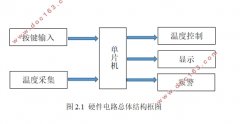PID温度控制系统设计

1.无需注册登录,支付后按照提示操作即可获取该资料.
2.资料以网页介绍的为准,下载后不会有水印.资料仅供学习参考之用.
密 惠 保
PID温度控制系统设计(任务书,开题报告,论文12000字)
摘要
温度控制在工业生产中起着巨大的作用,传统的控制方案有超调大、控制精度低、调节时间长等缺点。用单片机进行控制,具有电路较为简单、测量精度高、控制精度高且效果好等优点,能极大地提高生产效率。在实际运用中,PID控制算法是最常见的控制算法。本设计介绍了基于PID的温度控制系统的设计方案和设计的基本原理。本设计由硬件电路的设计和软件的设计组成。硬件电路由主控器件、温度采集电路、温控电路、按键输入电路、显示电路以及过温报警电路等组成。软件设计部分包括:主程序、DS18B20读温、报警处理、控制算法、按键处理等部分。
关键词:单片机;温度控制;PID控制算法
Abstract
Temperature control plays a great role in industrial production. Traditional control schemes have the weaknesses of overshoot, low control precision and long adjustment time. Single chip microcomputer control has the strong points of simple circuit, high measure precision, high control precision and good capability. Using it can greatly improve the production efficiency. In practical application, the PID algorithm is the most common control algorithm. This design introduces the design scheme and the basic principle of the temperature control system based on PID . The design is composed of hardware circuit design and software design. The hardware circuit is composed of a main control device, a temperature acquisition circuit, a temperature control circuit, a key input circuit, a display circuit and an over temperature alarm circuit. The software design includes: main program, DS18B20 reading temperature, alarm processing, control algorithm, key processing and so on. [资料来源:http://www.THINK58.com]
Key words: single chip microcomputer; temperature control; PID algorithm
[来源:http://www.think58.com]

目 录
摘要 I
Abstract II
第1章 绪论 1
1.1 课题研究的目的及意义 1
1.2 国内外研究现状和发展趋势 1
1.3 本文主要工作及结构安排 2
1.4 本章小结 2
第2章 系统硬件设计 4
2.1 系统硬件总体结构 4
2.2 单片机控制模块的设计 4
2.2.1 单片机的选用 5
2.2.2 AT89C52介绍 6
2.2.3 单片机控制模块的电路设计 6
2.2.4 电源设计 7
2.3 温度采集模块设计 8
2.3.1 DS18B20介绍 8
2.3.2 DS18B20内部结构 8
[资料来源:http://www.THINK58.com]
2.3.3 DS18B20供电方式 10
2.3.4 DS18B20引脚功能 10
2.4 温度控制模块设计 11
2.5 显示模块设计 13
2.6 按键电路的设计 15
2.7 报警模块的设计 15
2.8 本章小结 16
第3章 系统软件设计 17
3.1 主程序设计 17
3.2 DS18B20读温度程序的设计 17
3.3 键盘扫描程序的设计 18
3.4 报警处理程序的设计 20
3.5 PID控制算法 21
3.6本章小结 27
第4章 系统仿真与实物制作 28
4.1软件仿真 28
4.2 实物制作 30
4.3 本章小结 31
第5章 结论 32
参考文献 33
[资料来源:THINK58.com]
